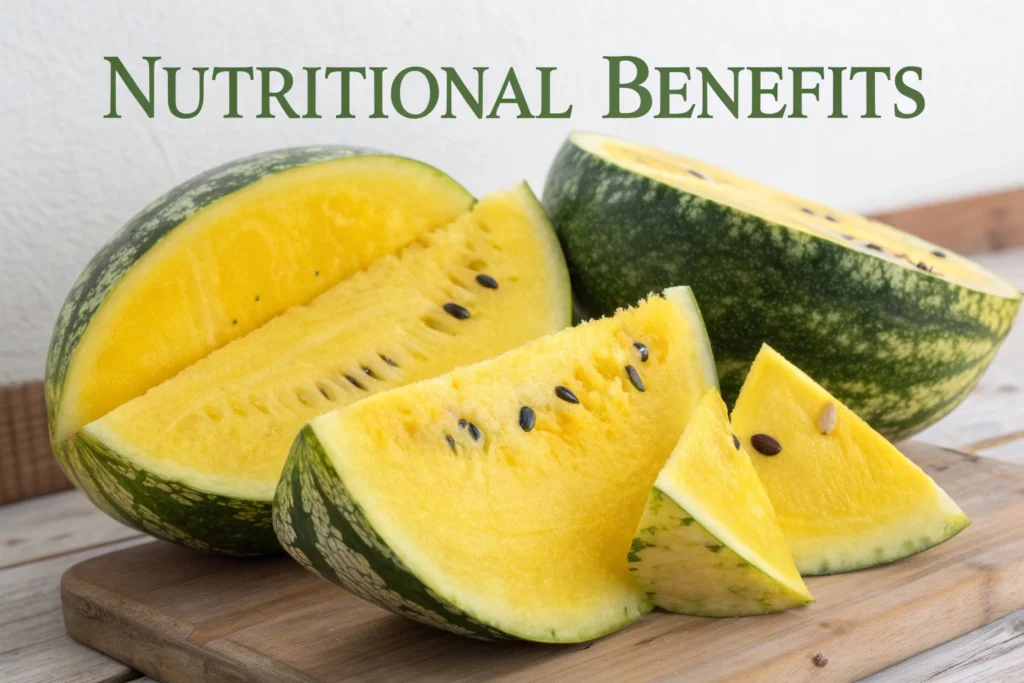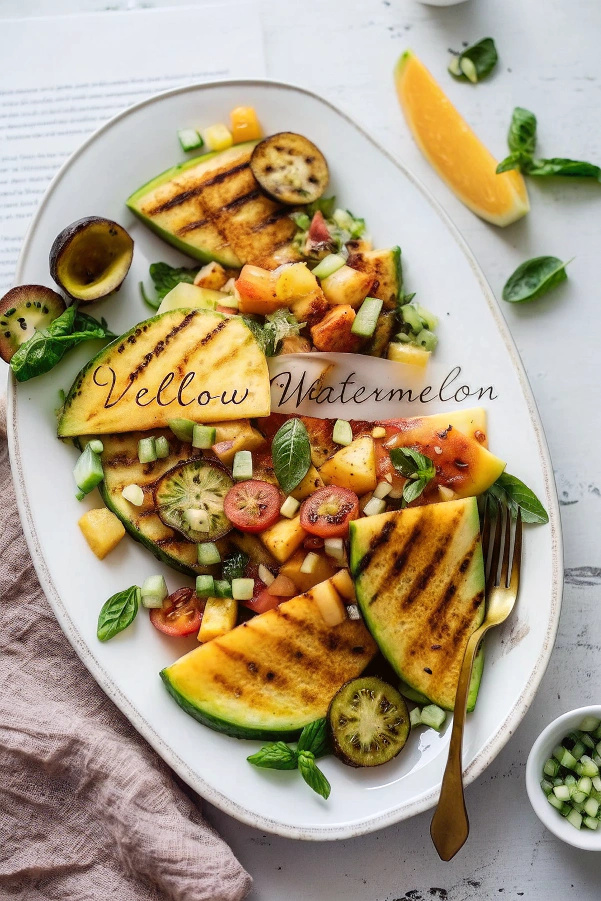What is a yellow watermelon? This unique variety of watermelon has been captivating fruit lovers with its surprising golden flesh, offering a delightful twist on the traditional red watermelon we all know. Unlike its common green-skinned counterpart, yellow meat watermelon boasts a honey-sweet flavor profile that sets it apart from other watermelon varieties. Interestingly, these vibrant fruits come in various forms, from the familiar yellow watermelon to rare purple-skinned varieties, each offering distinct tastes and textures. First discovered centuries ago, these colorful melons have evolved from the original watermelon species, developing their characteristic yellow color through natural cultivation. Not only do they provide a unique visual appeal, but yellow watermelon benefits also include essential nutrients and antioxidants. Whether you’re growing them in your own watermelon patch or selecting them at your local market, these golden beauties offer an exciting way to explore different types of watermelon. Their versatility in both sweet and savory dishes makes them a must-try fruit for any food enthusiast. Join us as we dive deeper into the fascinating world of yellow-fleshed watermelons and discover why they’re becoming increasingly popular among fruit lovers worldwide.
DO YOU HAVE A DOG ? ” Can dogs eat watermelon? ” is a common question among pet parents , Check out : Can Dogs Eat Watermelon? A Complete Safety Guide
What is Yellow WaterMelon: A Complete Guide to This Sweet Fruit
Understanding Yellow WaterMelon Varieties and Origins
Popular Types of Yellow-Fleshed WaterMelons Worldwide
Let’s dive into what is yellow Watermelon and explore its fascinating varieties! These sunny-colored fruits come in several exciting types. First, you’ve got the classic yellow watermelon, with its crisp, honey-sweet flesh that’s perfect for summer snacking. Then there’s the Canary melon, sporting a bright yellow rind and creamy interior. The Korean Yellow Watermelon offers a delightfully different taste with its smooth, pale flesh. Also, don’t miss the Crenshaw melon – it’s like a sweet surprise package with its salmon-yellow interior! Each variety brings its own unique flavor and texture to the table. Some are super sweet, while others have a hint of tanginess that makes them perfect for different uses. Next time you’re at the market, try spotting these golden beauties. They might look similar to regular watermelons from the outside, but inside, they’re packed with sunny goodness!
Historical Background and Cultivation Methods
Ever wondered how these golden treasures came to be? The story of yellow-fleshed melons is pretty amazing! These special varieties started popping up in farmers’ fields hundreds of years ago. First, they were discovered as natural mutations of regular watermelons in Africa. Then, clever farmers started selecting and growing the best yellow Watermelons they could find. Over time, they got better at growing these sunny fruits. The traditional growing methods were pretty simple – just good soil, lots of sunshine, and plenty of water. But modern farmers have some cool tricks up their sleeves! They use special techniques to make the melons even sweeter and juicier. These days, you can find yellow watermelons growing in sunny spots all around the world. From backyard gardens to big farms, these golden gems keep spreading joy and sweetness everywhere they go!
Nutritional Benefits of yellow watermelon and Health Properties

Essential Vitamins and Minerals in Yellow waterMelons
Let’s talk about the amazing goodness packed inside these golden fruits! When asking what is a yellow watermelon, you’ll be thrilled to learn about its fantastic health benefits. First off, they’re loaded with vitamin C – even more than regular watermelons! Then there’s beta-carotene, which gives them that beautiful yellow color and helps keep your eyes healthy. These sunny fruits are also packed with potassium, which is great for your heart. Plus, they’re super low in calories but high in fiber, making them perfect for healthy snacking. You’ll also find lots of antioxidants hiding in that sweet flesh. The best part? They’re made up of about 90% water, so they’re super refreshing and help keep you hydrated on hot days. Think of them as nature’s sports drink – but way more delicious!
How Yellow WaterMelons Support Wellness Goals
Ready to make your wellness journey more exciting? Yellow melons are here to help! These sweet treats are like nature’s candy, but they come with awesome health perks. First, they’re great for your skin thanks to all those antioxidants. Then, their high water content helps flush out toxins from your body. The natural sugars give you a quick energy boost without any crash later. Plus, they’re super filling while being low in calories – perfect for anyone watching their weight! They also help with digestion thanks to their fiber content. And here’s a cool fact: the nutrients in yellow watermelons can help reduce inflammation in your body. Whether you’re an athlete looking for natural hydration or just someone trying to eat healthier, these golden fruits have got your back!
Selecting and Storing Your Yellow WaterMelon
Tips for Choosing the Perfect Ripe WaterMelon
Getting ready to pick out a yellow Watermelon at the store? Let me share some fun tips to help you find the perfect one! First, give it a gentle pat – a ripe melon should sound hollow, like you’re knocking on a door. Next, check the color – look for a creamy yellow or golden hue without any green patches. The melon should feel heavy for its size – that means it’s full of sweet, juicy goodness! Don’t worry about small scratches on the surface; they’re totally normal. Give it a sniff near the blossom end – a sweet, fragrant smell means it’s ready to eat. If you can, gently press the blossom end – it should give slightly under pressure. And here’s a fun trick: look for a yellow spot where the melon sat on the ground – that’s called the field spot!
Storage Techniques for Maximum Freshness
Let’s keep that perfect yellow Watermelon tasting amazing! Once you’ve picked your golden treasure, storing it right is super important. First, if your melon isn’t quite ripe, let it hang out on your counter at room temperature. Keep it away from direct sunlight – think of it as giving your melon some nice shade! Once it’s ripe, pop it in the fridge to keep it fresh longer. Here’s a cool trick: wrap cut pieces in plastic wrap or store them in an airtight container. This keeps the sweet flavor locked in! Your Watermelon will stay fresh for about 3-5 days in the fridge. Remember to keep it away from strong-smelling foods – melons love to soak up other flavors. And here’s a pro tip: cutting your Watermelon into chunks right after buying makes it super easy to grab and enjoy!
Yellow WaterMelon Recipe Ideas and Serving Suggestions

Creative Ways to Enjoy Fresh Yellow WaterMelon
Let’s get creative with the yellow watermelon and turn it into something amazing! First, try cutting it into fun shapes using cookie cutters – kids absolutely love this! Next, make some super-refreshing yellow watermelon balls and freeze them for natural popsicles. You can also toss them into a summer salad with mint leaves and a splash of lime juice. How about yellow watermelon kabobs? Thread chunks onto skewers with other fruits for a colorful treat. Want something fancy? Wrap thin slices with prosciutto for a sweet and savory appetizer. You can even grill yellow watermelon slices – it brings out an amazing caramelized flavor! Make a fun fruit pizza using yellow watermelon as the star topping. These ideas are just the beginning – let your imagination run wild!
Incorporating Yellow WaterMelon in Smoothies and Desserts
Time to transform your yellow watermelon into some seriously yummy treats! Let’s start with smoothies – blend chunks of yellow watermelon with coconut water and a hint of mint for the most refreshing drink ever. Want something creamy? Mix it with yogurt and honey for a tropical smoothie bowl. You can also make amazing popsicles by blending yellow watermelon with a splash of lime juice. For desserts, try yellow watermelon sorbet – it’s super easy and tastes like summer in a bowl! Create beautiful parfaits by layering yellow watermelon with whipped cream and granola. How about some yellow watermelon fruit leather? It’s like making your own healthy candy! You can even make a no-bake cheesecake topped with yellow watermelon balls. These treats are perfect for hot days!
Growing Yellow WaterMelons in Your Garden
Essential Growing Conditions and Care Tips
Wondering how to grow a yellow watermelon in your own garden? Let’s make it super easy and fun! First, find a sunny spot – these plants love soaking up the rays! You’ll need well-draining soil mixed with some compost to keep your plants happy. Plant the seeds after all danger of frost has passed. Here’s a cool trick: create little soil mounds for better drainage. Water deeply but not too often – think of it as giving your plants a nice long drink instead of little sips. Mulch around the plants to keep weeds away and moisture in. Watch those vines grow – they’ll need plenty of space to spread out. Feed your plants with organic fertilizer every few weeks. Soon you’ll see flowers turning into tiny melons!
Common Challenges and Solutions for Home Growers
Don’t let growing challenges stop you from having your own yellow melon patch! First up, let’s tackle the most common issues. Seeing yellow leaves? That usually means your plants need more nutrients or water. Fruits not getting sweet enough? Make sure they’re getting plenty of sun and consistent water. Pesky bugs trying to munch on your melons? Try companion planting with marigolds or nasturtiums – they’re like natural bug repellents! If you spot powdery mildew, a mix of water and baking soda works wonders. Fruits cracking? That means uneven watering – keep it steady! Having trouble with pollination? Give the flowers a gentle shake in the morning to help spread pollen. These solutions are super simple and totally organic!
Frequently Asked Questions (FAQs)
Yes, dogs can eat watermelon, but only in moderation. Remove the seeds and rind first. They can be harmful if ingested. Watermelon is hydrating and has vitamins A and C, making it a refreshing treat. However, always check with your vet before introducing new foods to your dog’s diet. Treat it as a fun snack, not a meal replacement, to keep your furry friend happy and healthy.
Watermelon is incredibly healthy and hydrating! It’s packed with vitamins A, C, and antioxidants that boost your immune system. Plus, it’s low in calories and helps keep you refreshed on hot days. Its high water content also supports hydration and digestion. Whether you’re snacking or making smoothies, watermelon is a fantastic addition to your diet. It’s both nutritious and delicious!
Yes, cats can enjoy a little watermelon as a treat. Remove the seeds and rind first to keep it safe. The high water content can help keep your cat hydrated. However, cats are carnivores, so fruits should never replace their regular diet. Offer a tiny piece and see how they like it. Treats like this are a fun way to bond with your furry friend!
To check if a watermelon is ripe, tap it lightly—it should sound hollow. Look for a yellow spot on the rind where it rested on the ground; it should be creamy, not white. The melon should feel heavy for its size and have a firm, evenly-colored rind. These simple tips will help you pick the juiciest, sweetest watermelon every time!
Frequently Asked Questions (FAQs) P2
Yes, watermelon is a fruit! It grows from a flowering plant and contains seeds, just like other fruits. Its sweet, juicy flesh makes it a popular choice for desserts, snacks, and drinks. Fun fact: botanically, watermelon is also considered a type of berry because of its hard rind and juicy interior. No matter how you slice it, it’s a refreshing, fruity delight!
Surprisingly, yes! Watermelon is technically a berry because it develops from a single flower and has seeds inside. Its hard rind and juicy flesh fit the botanical definition of a berry. This fun fact might make you see watermelon in a whole new way! Whether you call it a berry or a fruit, it’s always delicious and refreshing.
Watermelon has natural sugars, but it’s not considered high in sugar. Its water content helps balance the sweetness. A cup of diced watermelon has about 9 grams of sugar, which is lower than many fruits. Enjoy it in moderation, especially if you’re watching your sugar intake. It’s a sweet treat that’s both refreshing and satisfying!
Watermelon is great for weight loss! It’s low in calories and packed with water, helping you feel full. Its natural sweetness can satisfy sugar cravings without adding too many calories. Plus, it’s rich in vitamins and antioxidants. Add it to your snacks or salads for a healthy boost. It’s a tasty way to stay on track with your weight-loss goals!
Frequently Asked Questions (FAQs) P3
Watermelon and salt may seem unrelated, but they pair surprisingly well. Salt enhances the sweet flavor of watermelon, making it even more delicious. Some people sprinkle a little salt on their watermelon slices for an unexpected taste twist. It’s a fun experiment if you’ve never tried it before! Just remember, a little salt goes a long way.
“Chicken and watermelon” is often referenced in culture, sometimes as a stereotype or joke. It’s also a unique flavor combination in some recipes. Fried chicken and watermelon salad, for example, blend savory and sweet. While the phrase may carry different meanings depending on context, it’s always fun to explore new food pairings!
Bad watermelon can smell sour or have a mushy texture. Check for slimy spots or mold on the rind. If the flesh looks dry, discolored, or has an off smell, it’s time to toss it. A fresh watermelon should smell sweet and feel firm. When in doubt, it’s better to be safe and get a new one!
You can tell watermelon is bad by its smell, texture, or appearance. If it smells sour or has a mushy, slimy texture, it’s spoiled. Look for mold or dark spots on the rind, which are clear signs of decay. The flesh should be bright and firm. If it looks dry or discolored, don’t eat it. Always trust your senses!
Frequently Asked Questions (FAQs) P4
Uncut watermelon can last up to 10 days at room temperature if stored properly. Keep it in a cool, dry place. Once cut, store it in the fridge to keep it fresh for 3–5 days. Always wrap cut pieces tightly with plastic wrap or store them in an airtight container. Proper storage helps maintain its juiciness and flavor!
You can find yellow watermelon at farmer’s markets, specialty stores, and sometimes in larger grocery chains. It’s usually more common during the summer months. Check with local produce vendors or online marketplaces for availability. Yellow watermelon might not be as common as the red variety, but it’s worth the hunt for its unique flavor and vibrant color!
Experience the Joy of Yellow WaterMelons: From Garden to Table
Now you know what is a yellow watermelon and all its wonderful secrets! These golden treasures are more than just a pretty fruit. They’re packed with nutrients, super versatile in recipes, and surprisingly easy to grow. Whether you enjoy them fresh from your garden or picked from the store, yellow watermelons bring a unique sweetness to your table. Plus, they’re perfect for sharing with friends and family at summer gatherings! Try growing your own for a fun garden adventure, or experiment with new recipes to discover your favorite way to enjoy them. Remember to pick the ripest ones for the best flavor, and store them properly to enjoy their sweetness longer. From refreshing snacks to fancy desserts, yellow watermelons are here to brighten your day and your plate. So go ahead – grab one and start your yellow melon journey today!
